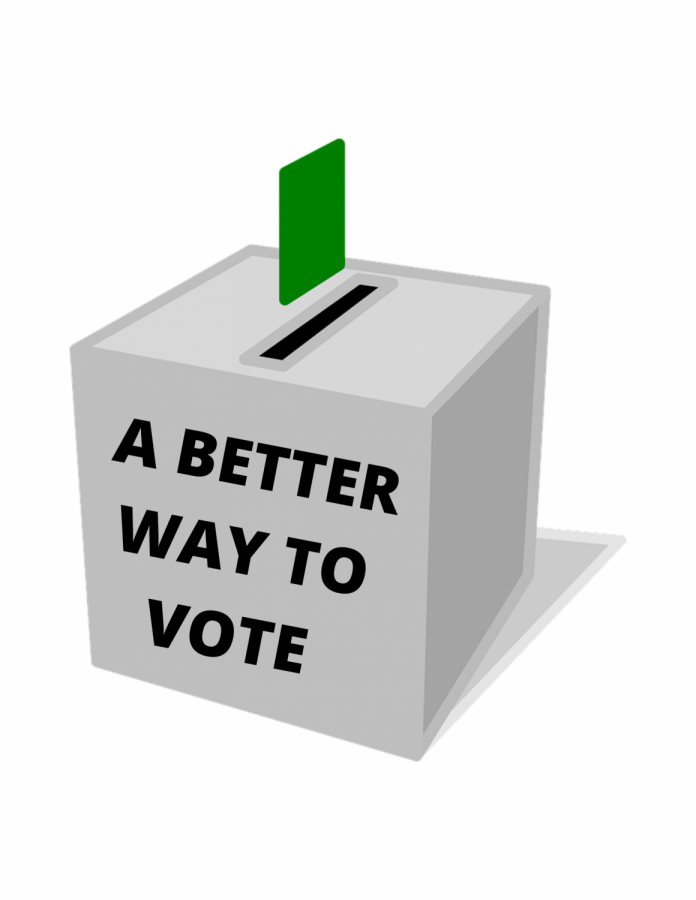A better way to vote
In the modern political landscape, so much of the debate surrounds the Electoral College that little attention is given to how the ballots themselves in all races are counted.
December 4, 2019
In the modern political landscape, so much of the debate surrounds the Electoral College that little attention is given to how the ballots themselves in all races are counted.
For all national and most state races, the U.S. uses first-past-the-post voting, which effectively means that the candidate with the greatest proportion of votes wins (not necessarily a majority). However, this system is incredibly flawed. For one, it means that a candidate only needs a plurality, not necessarily a majority of the votes, so minority rule becomes a possibility. First-past-the-post thus can and often does produce election winners that most citizens did not support, even though a plurality (the greatest proportion but not a majority) technically did. This has happened repeatedly throughout U.S. history, most notably with the 1992 presidential election, where, as the FEC stated, the winner garnered only 43 percent of the vote. While this issue is partially due to the Electoral College, first-past-the-post is the main culprit here because it does not require a majority.
Part of the cause of this phenomenon is the spoiler effect. In an election with two candidates, there is always a clear majority. But whenever additional candidates join the race, candidates that are ideologically similar to those already in the race will take some votes away from them (In 1992, this candidate was Ross Perot and in 2000, this was Ralph Nader). This splits the vote between two candidates that generally agree and have similar supporters, ensuring no majority. Because of this, the opposite side wins, despite most people not voting for them. Thus, third party votes are disincentivized.
One way to mitigate the effects of the spoiler effect would be to have a ranked choice voting system. Instead of simply marking off their most preferred or least despised candidates (‘the lesser of two evils’), voters can rank their candidates in order of preference. In ranked voting, the election outcome is determined by a series of ‘rounds.’ If there is no initial majority for first preference, votes in the first round for the candidate with the fewest first choice votes are redistributed to those voters’ second choices. Then, the process repeats and votes are reallocated in order of preference until there is a clear majority. When enacted, ranked voting could either be a method of determining a party’s primary winner or a way to circumvent primaries and shorten the election season.
The goal of this system is to find the most overall liked candidate on average, not necessarily the candidate with a plurality (the greatest number of votes). By allowing voters to rank the candidates to any degree at their discretion, ranked voting eliminates the need for strategic voting. Under such a system, voters do not need to vote for someone other than their preferred candidate simply because they do not think their candidate will win. Even if their first choice candidate is eliminated, a voter’s ballot still counts based on the number of ‘backup’ candidates they ranked. Additionally, ranked voting does not have a spoiler effect because voters who like multiple candidates can rank them all, regardless of what they think the chances of a candidate’s success are. This encourages a more diverse field of candidates or parties to run.
Ranked voting might sound like a hard to implement or unrealistic system but it is not. According to the RCV Resource Center, several countries, such as Ireland, Australia and Malta use ranked voting and have for more than a century in some cases. Several American cities have also adopted it, such as Minneapolis, San Francisco and Cambridge. Due to a People’s Veto, even the entire state of Maine will use ranked voting for the 2020 presidential election, as reported by the Bangor Daily News. Since Maine distributes Electoral College votes proportionally, they can award Electoral votes by district to the winner. The amount of support for ranked voting continues to grow, especially among politicians. Everyone from former Rep. John Porter and former Sen. John McCain to former President Barack Obama and Sen. Bernie Sanders have stated they support ranked voting, as Fair Vote noted.
Ranked voting would also likely eliminate several bureaucratic elements of the voting process, such as high-cost recounts or extremely lengthy election seasons. Negative, non-policy oriented campaigning is therefore reduced, as political scientist Larry Diamond noted. This is because if a candidate were to run an attack ad stating why a voter should be against a similar candidate, they would risk losing their spot as a second or third choice for that candidate’s supporters. This creates campaigns where candidates must speak to what policies they are for, not solely what they are against. As Betsy Sweet and Mark Eves explained during the 2018 Maine gubernatorial race, this system tends to lead to scenarios where “candidates work together to fight the issues that matter to their electorate.”
Opponents of ranked voting state that ballot exhaustion is a major problem with ranked voting. According to Democracy Journal, this means that, if a voter has not ranked enough candidates or just ranked one, “their ballot doesn’t figure in the outcome.” However, such a situation is unlikely because if voters only rank a single candidate, chances are that the support for that candidate is passionate and widespread, meaning they likely would not be eliminated right away. Ballot exhaustion is only a major problem for the first round of votes.
Another objection to ranked voting comes from the Center for Election Science, which contends that ranked voting is non-monotonic, meaning voters can raise the ranking of a candidate and cause them to lose. For this to happen, a majority of voters would have to deliberately rank an ideologically different candidate above an ideologically like-minded one. However, the probability of this happening is extremely low. Additionally, this can only happen in an election round with three remaining candidates in contention. Thus, non-monotonicity is essentially a non-issue.
The current first-past-the-post Electoral College system is riddled with inadequacies and shortcomings. But there is a time-tested alternative. If America wants to see itself or its electoral system as innovative, fair and representative, the time to adopt the better choice—ranked choice—is now.










